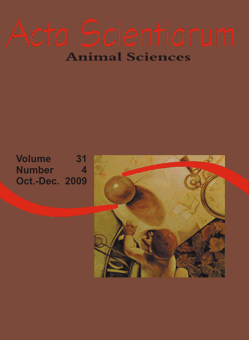<b>Nutritional value of diets containing cassava scrapings for feedlot sheep</b> - DOI: 10.4025/actascianimsci.v31i4.7153
Keywords:
alternative feed, voluntary intake, feed conversion, in vivo digestibility, weight gain
Abstract
The nutritional value of diets containing 0; 12; 24; 36 and 48% of cassava (Manihot esculenta Crantz) scrapings (CS) was evaluated for feedlot sheep. Twenty crossbred Santa Inês sheep, with average initial body weight of 17.0 ± 2.6 kg and 4-5 months of age were used in a performance and digestibility experiment. A completely randomized experimental design was adopted with five treatments (diets) and four replications (sheep). The inclusion of CS reduced (p < 0.05) NDF intake: Ŷg day-1 = 373.67 - 2.58X, R2 = 0.39; Ŷ%BW = 1.29 - 0.008X, R2 = 0.61 and Ŷg/BW0.75 = 29.89 - 0.19X, R2 = 0.56, as NDF digestible (Ŷg day-1 = 191.33 - 1.37X, R2 = 0.25). There was no effect (p > 0.05) of the inclusion level of CS on weight gain and feed conversion, with averages of 252.66 g day-1 and 4.86, respectively. The inclusion of CS increased linearly (p < 0.05) the digestibility of DM (Ŷ = 71.35 + 0.16X; R2 = 0.73), CP (Ŷ = 64.42 + 0.19X; R2 = 0.27) and ADF (Ŷ = 31.77 + 0.22X; R2 = 0.22). The nutritional value of diets with CS justify its use as an alternative ingredient of diets for ruminants in feedlot, and adjustments in diets to nutrients requirements are necessary, particularly protein.Downloads
Download data is not yet available.
Published
2009-10-30
How to Cite
Conceição, W. L. F., Figueirêdo, A. V. de, Nascimento, H. T. S. do, Vasconcelos, V. R., Alves, A. A., & Dantas Filho, L. A. (2009). <b>Nutritional value of diets containing cassava scrapings for feedlot sheep</b> - DOI: 10.4025/actascianimsci.v31i4.7153. Acta Scientiarum. Animal Sciences, 31(4), 397-402. https://doi.org/10.4025/actascianimsci.v31i4.7153
Issue
Section
Ruminant Nutrition
DECLARATION OF ORIGINALITY AND COPYRIGHTS
- I Declare that current article is original and has not been submitted for publication, in part or in whole, to any other national or international journal.
The copyrights belong exclusively to the authors. Published content is licensed under Creative Commons Attribution 4.0 (CC BY 4.0) guidelines, which allows sharing (copy and distribution of the material in any medium or format) and adaptation (remix, transform, and build upon the material) for any purpose, even commercially, under the terms of attribution.
Read this link for further information on how to use CC BY 4.0 properly.
0.9
2019CiteScore
29th percentile
Powered by 








































